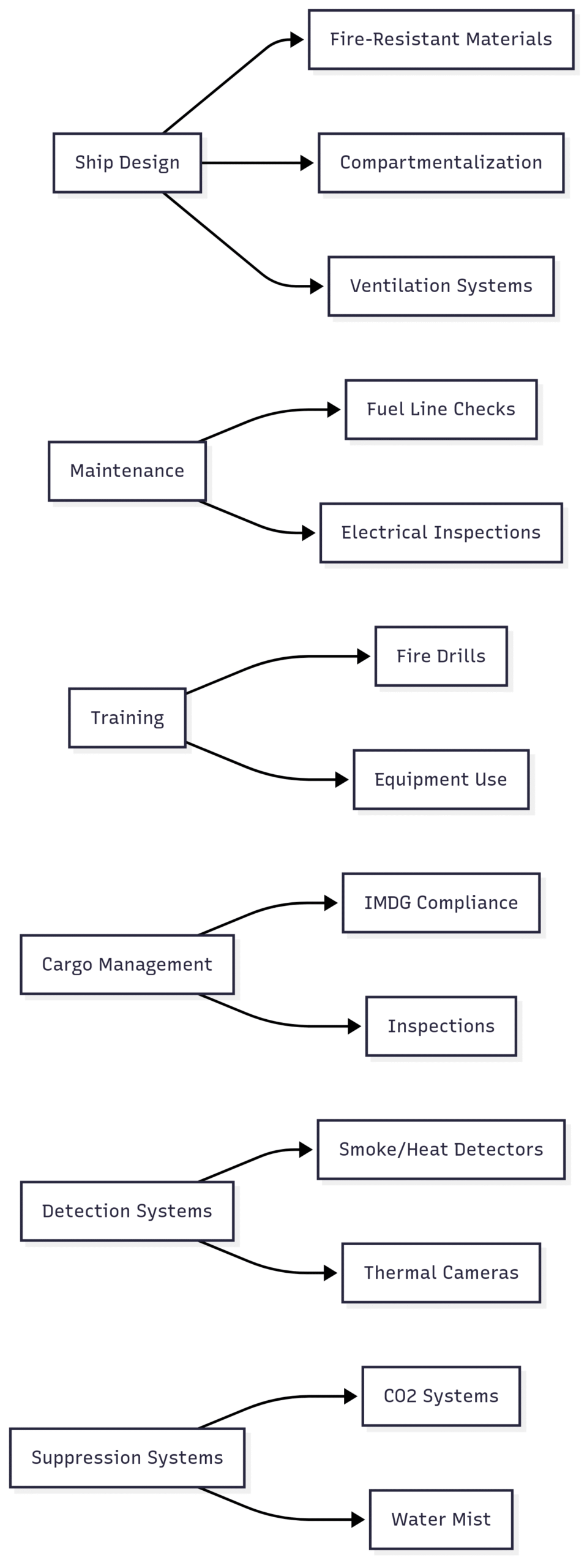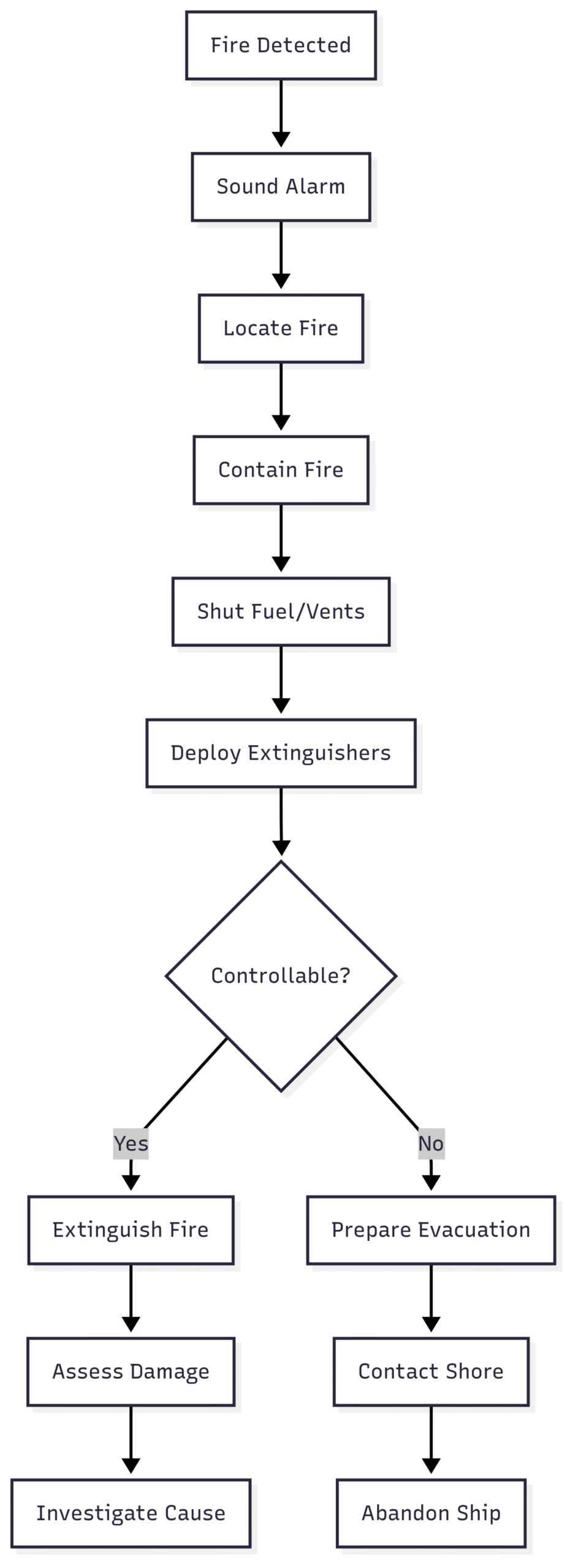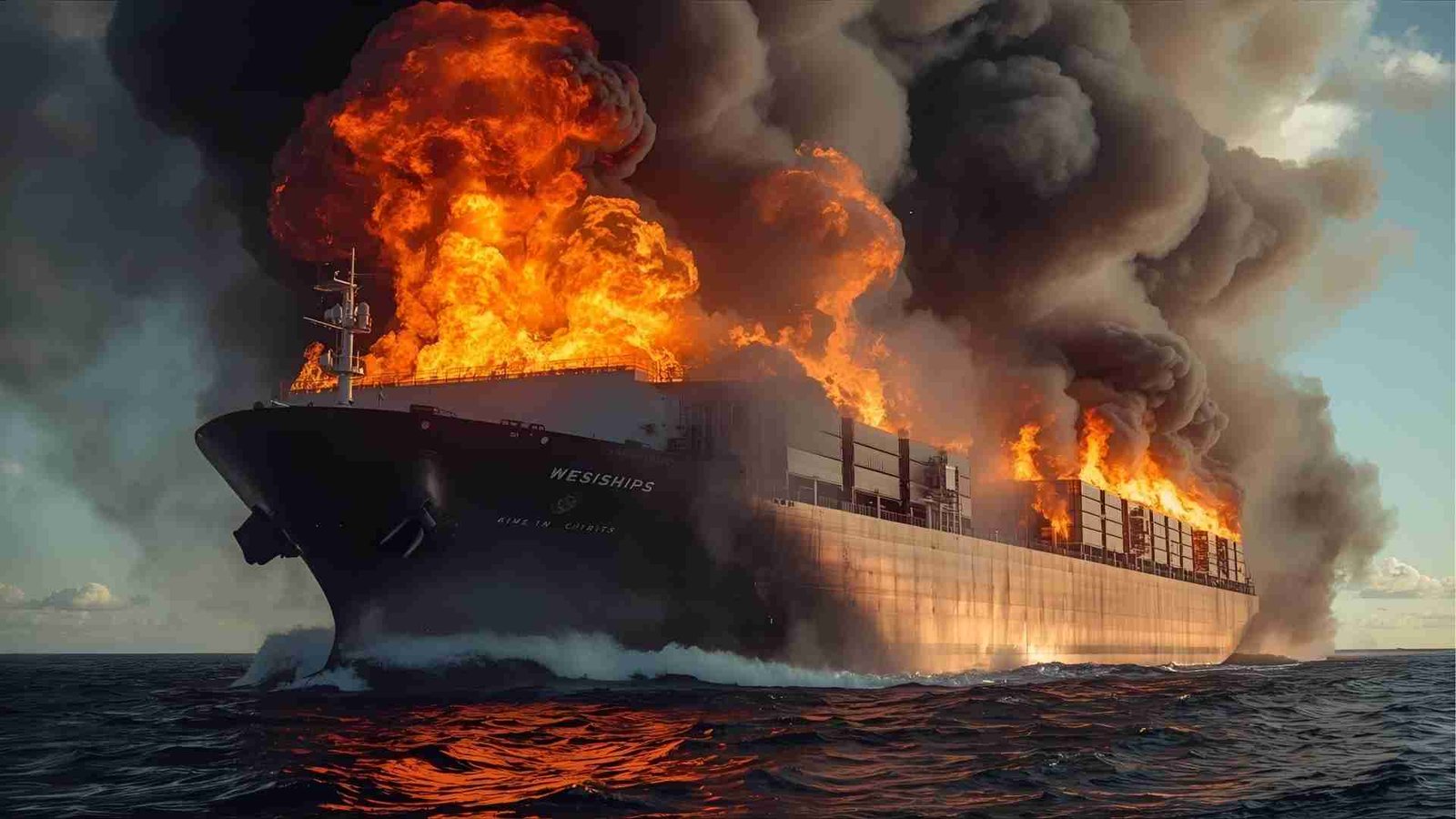Fire on Ships: Causes, Prevention, and Response
Ship fires pose a severe threat to maritime safety, crew lives, cargo, and the environment. Unlike land-based fires, escape options at sea are limited, making prevention and rapid response critical. This comprehensive guide explores the causes of ship fires, effective prevention strategies, and response protocols, providing actionable insights for maritime operators, crew members, and safety professionals. With detailed equipment recommendations, specifications, and legal considerations, this article aims to enhance safety and preparedness.
Understanding the Causes of Ship Fires
Ship fires arise from various sources, each requiring specific prevention and response measures. Below are the primary causes:
Flammable Liquids
Fuel, lubricating oils, and combustible gases are common in engine rooms and cargo areas. Leaks from fuel lines or tanks can ignite upon contact with hot surfaces or sparks. For example, a small diesel leak in an engine room can vaporize, creating a flammable atmosphere.
Electrical Faults
Faulty wiring, overloaded circuits, or damaged insulation can cause sparks or overheating. Electrical fires often start in hidden areas like cable runs, making early detection challenging. Older vessels are particularly vulnerable due to aging systems.
Human Error and Poor Housekeeping
Improper handling of flammable materials, smoking in unauthorized areas, or leaving oily rags in open spaces can lead to fires. Cluttered passageways obstruct access to firefighting equipment, exacerbating risks.
Hot Work
Welding, cutting, or grinding produces sparks that can ignite nearby combustibles. Without proper safety measures, such as fire-resistant barriers or fire watches, hot work is a significant fire hazard.
Spontaneous Combustion
Materials like oily rags, coal, or certain chemicals can self-ignite under specific conditions, such as heat or poor ventilation. Improper storage amplifies this risk.
Galley Hazards
Unattended cooking, grease buildup, or flammable items near hot surfaces in galleys can spark fires. Grease fires spread rapidly if not addressed with appropriate extinguishers.
Hazardous Cargo
Misdeclared or improperly stored hazardous materials, such as lithium-ion batteries, flammable liquids, or reactive chemicals, can ignite or cause explosions. Incompatible cargo stored together increases risks.
Arson or Sabotage
Though rare, intentional fires from crew members or external parties can cause significant damage. These incidents are often planned to maximize destruction.
| Cause | Risk Level | Common Locations |
|---|---|---|
| Flammable Liquids | High | Engine Room, Cargo Holds |
| Electrical Faults | High | Throughout Vessel |
| Human Error | Medium-High | All Areas |
| Hot Work | High | Maintenance Areas |
| Spontaneous Combustion | Medium | Storage Areas |
| Galley Hazards | Medium | Kitchen/Galley |
| Hazardous Cargo | High | Cargo Holds |
| Arson/Sabotage | Low | Any Area |
Prevention Strategies for Ship Fires
Preventing fires requires a multi-faceted approach, integrating design, maintenance, training, and technology. Below are key strategies:
Robust Ship Design
Modern ships incorporate fire-resistant materials, compartmentalization, and ventilation systems to reduce fire risks. Engine rooms feature fireproof bulkheads, and galleys include grease-resistant surfaces. Standards like SOLAS (Safety of Life at Sea) mandate fire-safe construction.
Regular Maintenance
Routine inspections of fuel lines, electrical systems, and machinery prevent leaks and faults. For example, checking for worn insulation or loose connections reduces electrical fire risks. Maintenance schedules should align with manufacturer guidelines and IMO regulations.
Comprehensive Crew Training
Crew members must be trained in fire prevention, equipment use, and emergency response. Regular drills simulate engine room, galley, or cargo fires, ensuring familiarity with protocols. Training should cover:
- Safe handling of flammable materials
- Fire extinguisher operation
- Evacuation procedures
Cargo Management
Thorough cargo inspections ensure proper declaration and stowage. Hazardous materials must be segregated per IMO’s International Maritime Dangerous Goods (IMDG) Code. For instance, lithium-ion batteries require specific containers to prevent thermal runaway.
Fire Detection and Suppression Systems
Advanced detection systems, including smoke, heat, and flame detectors, provide early warnings. Fixed suppression systems, such as CO2 or water mist, are critical for engine rooms and cargo holds. Regular testing ensures reliability.
| Equipment | Specifications | Price (USD) |
|---|---|---|
| Kidde Smoke Detector | Dual-sensor (ionization/photoelectric), 85dB alarm, 10-year battery | $35 |
| Amerex B402 Fire Extinguisher | 5lb ABC dry chemical, 12-18ft range, UL-rated | $60 |
| Ansul Sapphire System | Clean-agent suppression, 25lb tank, covers 1,200 cu.ft | $2,500 |
| FLIR Thermal Camera | 320×240 resolution, detects heat leaks, Wi-Fi enabled | $700 |
Controlled Hot Work
Hot work requires permits, fire watches, and flame-resistant barriers. Sparks must be contained, and combustible materials removed from the area. Post-work inspections ensure no smoldering remains.
Proper Ventilation
Ventilation systems in engine rooms and cargo holds prevent vapor buildup. Regular cleaning of ducts avoids dust accumulation, which can fuel fires.
Good Housekeeping
Cleanliness reduces fire hazards. Oily rags must be stored in flame-resistant metal bins, and passageways kept clear. Regular waste disposal prevents combustible buildup.

Effective Response to Ship Fires
Rapid, coordinated response is critical to contain fires and protect lives. Below are the steps:
Locate and Inform
Identify the fire’s source using detection systems or visual inspection. Sound the fire alarm and notify the crew via intercom or radio. For serious fires, issue a distress call on marine VHF Channel 16.
Contain the Fire
Close fuel valves, shut vents, and seal hatches to starve the fire of oxygen and fuel. Fire doors and dampers limit spread. For cargo fires, isolate affected holds.
Extinguish
Use appropriate equipment based on fire type:
- Class A (wood, paper): Water or ABC extinguishers
- Class B (liquids): Foam or CO2
- Class C (electrical): CO2 or dry chemical
- Class K (grease): Wet chemical extinguishers
Firefighting teams, trained per STCW (Standards of Training, Certification and Watchkeeping), should deploy equipment swiftly.
Evacuation
If the fire is uncontrollable, prepare lifeboats and rafts. Crew must know muster stations and evacuation routes. Abandoning ship is a last resort due to open-sea dangers.
Communication with Shore
Contact coast guard or nearby vessels for assistance. GMDSS (Global Maritime Distress and Safety System) ensures reliable communication.
Post-Incident Actions
Assess damage, investigate causes, and repair systems. Medical care for crew and environmental cleanup may be needed.
Case Studies: Lessons from Past Incidents
Historical incidents highlight the importance of prevention and response:
MS Scandinavian Star
A fire, later ruled arson, killed 159 people. Inadequate fire detection and escape routes worsened the outcome, emphasizing the need for robust systems.
SS Grandcamp
A cargo fire ignited ammonium nitrate, causing an explosion that killed nearly 600. Proper cargo handling could have prevented the disaster.
MV Conception
A galley fire spread to sleeping quarters, killing 34. The incident underscored the need for accessible escape routes and early detection in accommodation areas.
Ocean Guardian
An incorrect bearing caused an engine room fire, resulting in $1 million in damage. Proper maintenance and part verification could have avoided this.
Container Ship Fires: A Growing Concern
Container ships carry vast quantities of cargo, including hazardous materials, increasing fire risks. Misdeclared goods, like lithium-ion batteries, can ignite spontaneously. Electrical malfunctions and overheating cargo exacerbate dangers.
Risks and Consequences
- Loss of Life: Crew may be trapped or suffer smoke inhalation.
- Environmental Damage: Toxic spills harm marine ecosystems.
- Economic Impact: Cargo losses and supply chain disruptions cost billions.
Legal Recourse for Victims
Maritime law offers compensation avenues:
Jones Act
Seamen can claim for injuries due to employer negligence, covering medical costs and lost wages.
Longshore and Harbor Workers’ Compensation Act (LHWCA)
Non-seamen maritime workers receive benefits for medical and disability costs.
Product Liability
Defective products, like faulty batteries, allow claims against manufacturers.
Environmental Claims
Governments can seek damages for pollution cleanup.
Wrongful Death
Families of deceased crew can file for funeral costs and emotional distress.
For legal assistance, firms like Kherkher Garcia (713-333-1030) specialize in maritime claims.
Industry Regulations and Best Practices
The IMO sets standards via SOLAS and IMDG codes, mandating:
- Cargo inspections
- Fire system maintenance
- Crew training
- Proper stowage
Compliance reduces risks significantly.
Recommended Equipment for Fire Safety
| Equipment | Specifications | Price (USD) |
|---|---|---|
| FireHawk Fire Blanket | 1x1m, fiberglass, handles 1,000°F, reusable | $25 |
| First Alert CO2 Extinguisher | 5lb, 10-second discharge, UL-rated | $80 |
| Dräger PARAT Escape Hood | 15-min smoke protection, CO-resistant | $150 |
| Notifier Fire Alarm Panel | Multi-zone, integrates smoke/heat detectors | $1,200 |
Emergency Preparedness Tips
- Fire Drills: Conduct monthly, simulating various scenarios.
- Equipment Checks: Inspect extinguishers and hoses quarterly.
- Fire Plan: Post clear evacuation routes and protocols ship-wide.
- Smoking Policies: Enforce designated areas with fireproof disposal.

Conclusion
Ship fires are preventable with rigorous maintenance, training, and compliance with safety standards. Rapid response and proper equipment are crucial when fires occur. By understanding causes, implementing prevention strategies, and preparing for emergencies, maritime operators can protect lives, vessels, and the environment. For those affected, legal options ensure accountability and compensation.
Happy Boating!
Share Fire on Ships: Causes, Prevention, and Response with your friends and leave a comment below with your thoughts.
Read Maritime Education in the USA: Preparing the Next Generation of Seafarers and Mariners until we meet in the next article.






